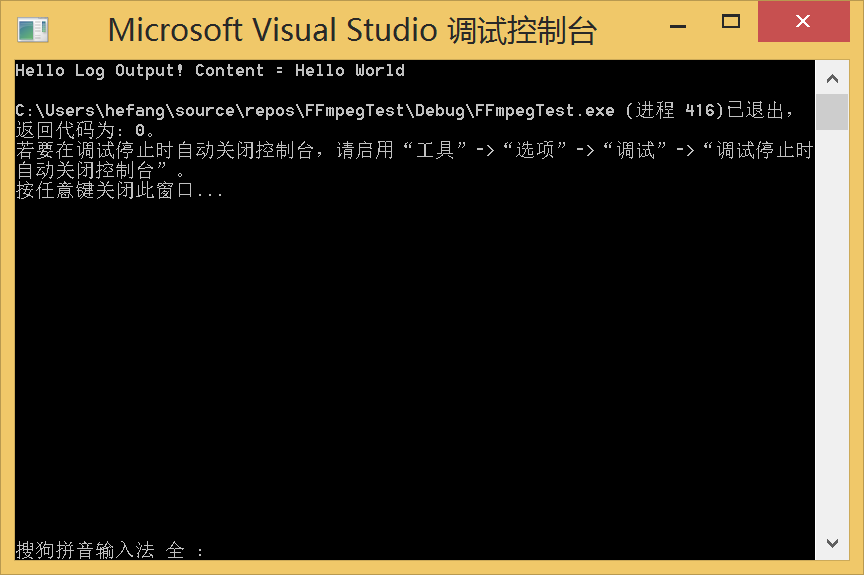FFmpeg开发实战(一):FFmpeg 打印日志
在Visual Studio 开发(二):VS 2017配置FFmpeg开发环境 一文中,我们配置好了FFmpeg的开发环境,下面我们开始边实战,边学习FFmpeg。
首先,我们要学习的就是FFmpeg的日志输出系统 。
一、FFmpeg 日志输出系统介绍
FFmpeg 日志输出的核心函数方法为: av_log() 。为什么说av_log()是FFmpeg中输出日志的核心函数函数?
因为我们随便打开一个FFmpeg的源代码文件,就会发现其中遍布着av_log()函数。一般情况下FFmpeg类库的源代码不允许使用printf()这种函数,所有的输出一律使用的av_log()。
二、av_log() 函数说明
av_log()的声明位于libavutil\log.h,具体的声明代码如下:
/** * Send the specified message to the log if the level is less than or equal * to the current av_log_level. By default, all logging messages are sent to * stderr. This behavior can be altered by setting a different logging callback * function. * @see av_log_set_callback * * @param avcl A pointer to an arbitrary struct of which the first field is a * pointer to an AVClass struct. * @param level The importance level of the message expressed using a @ref * lavu_log_constants "Logging Constant". * @param fmt The format string (printf-compatible) that specifies how * subsequent arguments are converted to output. */ void av_log(void *avcl, int level, const char *fmt, ...) av_printf_format(3, 4);
其中第一个参数指定该log所属的结构体,例如AVFormatContext、AVCodecContext等等。第二个参数指定log的级别,第三个参数为要输出的内容,源代码中定义了如下几个级别:
/** * Print no output. */ #define AV_LOG_QUIET -8 /** * Something went really wrong and we will crash now. */ #define AV_LOG_PANIC 0 /** * Something went wrong and recovery is not possible. * For example, no header was found for a format which depends * on headers or an illegal combination of parameters is used. */ #define AV_LOG_FATAL 8 /** * Something went wrong and cannot losslessly be recovered. * However, not all future data is affected. */ #define AV_LOG_ERROR 16 /** * Something somehow does not look correct. This may or may not * lead to problems. An example would be the use of '-vstrict -2'. */ #define AV_LOG_WARNING 24 /** * Standard information. */ #define AV_LOG_INFO 32 /** * Detailed information. */ #define AV_LOG_VERBOSE 40 /** * Stuff which is only useful for libav* developers. */ #define AV_LOG_DEBUG 48
从定义中可以看出来,av_log()的日志级别分别是:
AV_LOG_PANIC,AV_LOG_FATAL,AV_LOG_ERROR,AV_LOG_WARNING,AV_LOG_INFO,AV_LOG_VERBOSE,AV_LOG_DEBUG。
每个级别定义的数值代表了严重程度,数值越小代表越严重。
默认av_log()输出的级别是AV_LOG_INFO。
三、设置日志输出等级
在上面,我们讲到av_log()函数是可以设置日志的内容的等级的。而对于输出的日志内容,我们也是可以设置等级的。FFmpeg提供了av_log_set_level()用于设置当前Log的级别。
函数声明如下:
/** * Set the log level * * @see lavu_log_constants * * @param level Logging level */ void av_log_set_level(int level);
查看函数代码实现:
static int av_log_level = AV_LOG_INFO;
可以看出,设置日志输出等级主要是操作静态全局变量av_log_level。该变量用于存储当前系统Log的级别。
四、日志输出实战
通过下面的代码,我们就可以理解上面讲的日志输出及设置日志输出等级的逻辑了。
#include "pch.h" #include <iostream> extern "C"{ #include "libavutil/log.h" } int main(int argc, char* argv[]) { av_log_set_level(AV_LOG_ERROR); av_log(NULL, AV_LOG_INFO, "Hello World\n"); return 0; }
五、自定义FFmpeg日志输出
从文章开头的函数调用图可以看到,av_log()调用了av_vlog(),av_log()调用了一个函数指针av_log_callback。av_log_callback是一个全局静态变量,定义如下所示:
static void (*av_log_callback)(void*, int, const char*, va_list) = av_log_default_callback;
从代码中可以看出,av_log_callback指针默认指向一个函数av_log_default_callback()。av_log_default_callback()即FFmpeg默认的Log函数。
需要注意的是,这个Log函数是可以自定义的。按照指定的参数定义一个自定义的函数后,可以通过FFmpeg的另一个API函数av_log_set_callback()设定为Log函数。
查看源码,可以看到 av_log_set_callback() 的声明如下:
/** * Set the logging callback * * @note The callback must be thread safe, even if the application does not use * threads itself as some codecs are multithreaded. * * @see av_log_default_callback * * @param callback A logging function with a compatible signature. */ void av_log_set_callback(void (*callback)(void*, int, const char*, va_list));
从声明中可以看出,需要指定一个参数为(void*, int, const char*, va_list),返回值为void的函数作为Log函数。
查看av_log_set_callback() 源码,可以看到此方法只是做了一个函数指针赋值的工作,代码如下:
void av_log_set_callback(void (*callback)(void*, int, const char*, va_list)) { av_log_callback = callback; }
这样我们可以自定义一个my_logoutput()函数作为Log的输出函数:
void my_logoutput(void* ptr, int level, const char* fmt,va_list vl){ ****(省略....) }
编辑好函数之后,使用av_log_set_callback()函数设置该函数为Log输出函数即可。
av_log_set_callback(my_logoutput);
下面是自定义日志输出的实例源码:
#include "pch.h" #include <iostream> extern "C"{ #include "libavutil/log.h" } void my_logoutput(void* ptr, int level, const char* fmt, va_list vl) { printf("Hello Log Output! Content = %s", fmt); } int main(int argc, char* argv[]) { av_log_set_callback(my_logoutput); // 设置自定义的日志输出方法 av_log(NULL, AV_LOG_INFO, "Hello World\n"); return 0; }
输出如下:

附:本文涉及C语言知识点 --> 函数指针。



